Our perennial pasture demonstration is up and away!
Over the past seven months, perennials have been established on 51 hectares across seven farms between Busselton, Brunswick and Boyup Brook.
We thought you might be interested to know what was sown and how paddocks were established, so here’s what’s happened so far.
Growers are listed in order of seeding time. A list of all species selections, locations and indicative seed costs is available at the bottom of the article.
Manjimup Grower 1
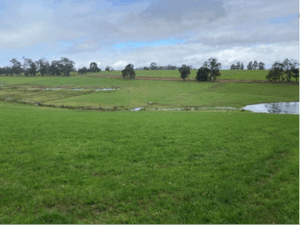
Our Manjimup Grower 1 is on a gravelly loamy sand with extremely high PBI and soil pH of 6.2 (CaCl2).
He chose to integrate perennials into his pastures following a veggie crop where weed pressure was reduced.
This grower retained irrigation in the paddock for a few weeks to assist establishment. The paddock was prepared in early March by spraying non-selective herbicide Basta and treated water repellence with Wetcit. He then seeded on 25 March with:
- 4Front Ryegrass (improved Bealey) at 10Kg/ha
- Holdfast Phalaris at 10Kg/ha
- Kainui Cocksfoot at 10Kg/ha.
The grower applied PK Hort fertiliser and sulphate of ammonium after seeding based on soil test results.
The pasture was well established by June and has been grazed several times already for one day at a time.
Busselton Grower
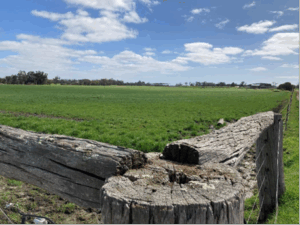
Our Busselton Grower and dairy producer is on sand with very low PBI, some waterlogging and soil pH of 5.5.
He manages a fairly heavy kikuyu prevalence, so prepared his paddock by using a knockdown spray mid-April, appling compost a week later and mouldboard ploughing a few days after that. He then ran a power harrow over to level the soil.
The grower chose to seed:
- Samurye ryegrass at 25Kg/ha (Hybrid – 50% perennial (Bealey), 50% annual (Italian) with a predicted lifespan of 2-4 years),
- Haifa White Clover at 12.5Kg/ha.
He sowed in early May after a 25 mm rainfall event, and seeded with soaknwet for water repellence and chloropyrophos for red-legged earth mites.
Since early July the paddock has been grazed once a month for 12 hours each time. After each grazing the paddock is fertilised with nitrogen and sulphur. He commented in August that the paddock looks similar to surrounding annuals.
Manjimup Grower 2
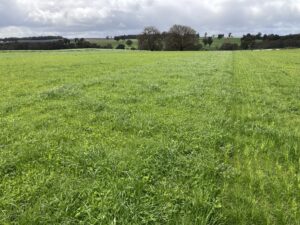
Manjimup Grower 2 is on gravelly loamy sand with extremely high PBI and soil pH of 4.8. She chose to plant perennials into a paddock that had just come out of potatoes because the rotation had reduced weed pressure. She applied a glyphosate knockdown in early May on reemerging plants, then sowed the following perennial species in late May:
Mix 1: applied to 91% of the paddock at varying rates
- Aber green ryegrass at 15.6Kg/ha
- Abergain ryegrass at 15.6Kg/ha
- Chicory at 2Kg/ha
- Howlong Cocksfoot at 3.8Kg/ha
- Holdfast Phalaris at 3Kg/ha.
Mix 2: Barenbrug southwest perennial mix (perennial and hybrid ryegrasses and clovers including sub clover) – applied on 11% of paddock. There was a small crossover between mixes pictured above.
The grower reported that after good early growth the pasture stalled due to cold weather and waterlogging in some places. Broadleaf weeds emerged in late August, so the grower sprayed Thristol Gold in mid-October when the chicory had reached 6 leaf stage and had built resilience to the chemical. The paddock has been out of the grazing rotation while the perennials establish and is planned to be grazed in late October (as annual grasses are emerging) and will be followed by an application of nitrogen.
Boyup Brook Grower
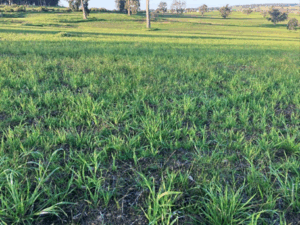
Our Boyup Brook Grower prepared his paddock by spreading gyplime (based on soil test results) and applied a glyphosate and oxyflourefen Li700 knock-down spray in early May.
He followed up with a second knock-down spray in late May using paraquat and Hammer. He mixed and coated his seed with Crop Solutions Black and guacho in early June and sowed two days later.
The seeds he chose to sow this season were:
- Advanced AT Phalaris at 3.6Kg/ha
- Temora Fescue at 1.8Kg/ha
- Uplands Cocksfoot at 1.8Kg/ha
- Commander Chicory at 1.8Kg/ha
- Chico Plantain at 1.8 kg/ha
- Caucasian White Clover at 1.8Kg/ha.
The seeds were sown with a disc and press wheel with an application of super. After a slow start, growth rates increased in late September and grasses have established very well, although there is some patchiness in germination, which could be due to seeding a bit too deep, with small amounts of chicory and plantain and virtually no white clover yet.
Perup Grower
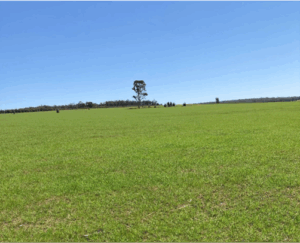
Our Perup Grower is on gravelly loamy sand with a soil pH of 5.0. His paddock was a bluegum plantation harvested in 2022. The grower applied a glyphosate knockdown spray in late June as well as alphacypermethrin for insect pests. The paddock was then ploughed and levelled in early July followed by a second knockdown spray using Sprayseed for ryegrass and winter grass.
In mid-July the grower seeded a mix of:
- Trespono Cocksfoot at 3 kg/ha
- Holdfast Phalaris at 3 kg/ha,
- Avalon Ryegrass at 9 kg/ha.
After seeding he applied Biosoil wetter, as well as phosphorus and potassium fertiliser.
The paddock was grazed in late October to knock down emerging annual grasses and will be followed by a nitrogen application. Perennials are present but slow growing.
Brunswick Grower
One Brunswick Grower is trialling a spring sowing with his seeds going in on October 1. This was later than planned due to flooding in the paddock from a wet winter. The paddock is a sandy loam with pH 5.5. To prepare the paddock the grower used a glyphosate knock down spray in late August, and then again late September. He then mulched before seeding. After soil testing, single super was applied to address low phosphorus earlier in 2025, and lime and gypsum was also applied.
The grower chose to seed:
- Blend of Fortune (summer active) Tall Fescue (80%) and Howlong Cocksfoot (20%) at 13.6 and 3.4 kg per hectare respectively on half the paddock,
- Blend of Prosper (summer dormant) Tall Fescue (80%) and Howlong Cocksfoot (20%) at 12 kg and 3 kg per hectare on the other half.
Early days but establishment is described as very slow.
Busselton Grower 2
A second grower planned a spring seeding to allow more time for weed control. His paddock is a flood prone clay loam with a pH of 4.8. Winter rainfall also delayed seeding well into October. However, the decision to proceed in spring was made because he has a water-reel to irrigate with.
The paddock was prepared with two knock-down sprays and two passes with discs. Diammonium phosphate and lime was applied to lift soil pH and address a marginal phosphorus soil test.
The grower focused on species suitable to his soil and wet landscape and went with:
- Tall fescue at 3 kg/ha
- Holdfast Phalaris at 3 kg/ha
- Palestine Strawberry clover at 3 kg/ha (balansa clover also sown – at 3kg/ha)
Concluding thoughts
These growers have followed recommendations shared during our Perennial Question Q&A sessions earlier this year. Information on those discussions can be found here. The following key points that have been reflected in the above grower’s decision making:
The paddock chosen had low weed pressure and was well prepared ideally using at least knockdown sprays. Soil constraints were addressed based on soil test result. Given the cost of seed, growers made sure there was adequate nutrition and were aware of potential impacts from pests.
Grazing was deferred initially and then grazed in short spells followed by rests of a month to encourage perennials. Later sowings meant the deferrment period was significant.
Grasses were more often selected by growers than herbs because it leaves options for managing broadleaf weeds. A lot of the growers have sub-clover in the seed bank and will rely on that emerging for a clover component.
Our sustainable agriculture team will be heading out to each perennial site over the next few months to do pasture composition surveys, looking at what’s working well, where there has been challenges in establishment and why.
Stay tuned.

This demonstration forms part of the FEaST Project which is supported by the Australian Government through funding from the Natural Heritage Trust under the Climate-Smart Agriculture Program and delivered by South West NRM, a member of the Commonwealth Regional Delivery Partners panel.
